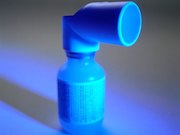Benefits seen for triple therapy with fluticasone furoate, umeclidinium, and vilanterol
WEDNESDAY, April 18, 2018 (HealthDay News) — For patients with chronic obstructive pulmonary disease (COPD), triple therapy is associated with a reduced rate of exacerbations, according to a study published online April 18 in the New England Journal of Medicine.
David A. Lipson, M.D., from GlaxoSmithKline in Collegeville, Pa., and colleagues conducted a randomized trial involving 10,355 patients with COPD. Fifty-two weeks of a once-daily combination of fluticasone furoate (an inhaled glucocorticoid), umeclidinium (a long-acting muscarinic antagonist), and vilanterol (a long-acting β2-agonist) was compared with fluticasone furoate-vilanterol and umeclidinium-vilanterol. Each of the regimens was administered in a single inhaler.
The researchers found that the rate of moderate or severe exacerbations was 0.91 per year in the triple-therapy group, compared with 1.07 in the fluticasone furoate-vilanterol group (rate ratio with triple therapy, 0.85) and 1.21 in the umeclidinium-vilanterol group (rate ratio with triple therapy, 0.75). The annual rate of severe exacerbations resulting in hospitalization was 0.13 in the triple therapy group, compared with 0.19 in the umeclidinium-vilanterol group (rate ratio, 0.66). The incidence of pneumonia was higher in the inhaled-glucocorticoid groups than in the umeclidinium-vilanterol group. A significantly higher risk of clinician-diagnosed pneumonia was seen with triple therapy versus umeclidinium-vilanterol (hazard ratio, 1.53).
“Triple therapy with fluticasone furoate, umeclidinium, and vilanterol resulted in a lower rate of moderate or severe COPD exacerbations than fluticasone furoate-vilanterol or umeclidinium-vilanterol in this population,” the authors write.
Several authors disclosed financial ties to GlaxoSmithKline, which funded the study.
Copyright © 2018 HealthDay. All rights reserved.








